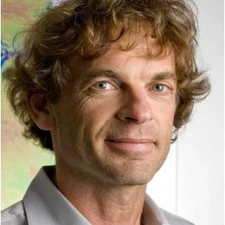Eric Rignot

The 2017 Louis Agassiz Medal is awarded to Eric Rignot for fundamental innovations in the remote sensing of glacier flow, leading to the first assessments of the mass balance of the ice sheets of Antarctica and Greenland.
As a senior research scientist at the Jet Propulsion Laboratory (JPL) and later as professor at the University of California, Irvine, Eric Rignot revolutionised satellite radar interferometry techniques to study the spatial and temporal variability of glacier flow in Antarctica, Greenland and smaller ice masses. By merging disparate satellite and ground-based observations with models, he synthesised a complete picture of the motion and mass balance of the great ice sheets. In 2011, he published the first continent-wide map of Antarctic ice flow, a true milestone in observational glaciology showing just how dynamic this huge ice mass ice is. Rignot pioneered the ‘flux-gate method’, in which he combined glacier discharge for the entire perimeter of the ice sheets with models and observations of snow accumulation and melt. This enabled him to quantify how fast the world’s largest glacier systems are losing mass, and to identify the leading processes. This pioneering work led to numerous high-profile publications and the critical insights that recent Antarctic and Greenland mass loss is accelerating, and that melting of the West Antarctic ice sheet is essentially irreversible. For his groundbreaking scientific work, Rignot received multiple awards. e.g. from NASA, JPL and the American Geophysical Union. In addition to these remarkable scientific achievements, Eric Rignot also served the scientific community in several influential ways, being editor of the leading scientific journal Geophysical Research Letters for seven years and lead author of the IPCC reports published in 2007 and 2013. He led six oceanographic surveys in Greenland, three airborne campaigns in Antarctica, four airborne surveys in Patagonia, three airborne surveys in Alaska, and four radar echo sounding and radar interferometry airborne deployments in Greenland. Moreover, he currently is Science Lead for NASA’s Operation IceBridge mission and Deputy Lead for NASA’s Ocean Melting Greenland mission. Rignot actively teaches and supervises at the undergraduate, graduate, doctoral and postdoctoral levels. Under his leadership, the next generation of glaciologists is developing the open-source Ice Sheet System Model. Over the last two decades, for an important part due to Rignot’s scientific leadership, we have come to recognise that the Earth’s ice sheets and glaciers are changing more rapidly than anticipated. In numerous media interviews, he never fails to warn for the huge impact that anthropogenic global warming will have on the mass loss of ice sheets and glaciers and therewith on sea level rise. Through his impact and worldwide leading position in research, service and outreach, Eric Rignot is an exceptional recipient of the Louis Agassiz Medal.
